Dielectric Surface Flashover under Long-Term Repetitive Microsecond Pulses in Compressed Gas Environment
Abstract
:1. Introduction
2. Materials and Methods
2.1. Experimental Setup
2.2. Test Electrodes and Insulator Samples
2.3. Experimental Measurements and Procedures
3. Results
3.1. SIL under RMPs
3.1.1. The Influence of Gas Species
3.1.2. The Influence of Gas Pressure
3.1.3. The Influence of Insulator Materials
3.1.4. The Influence of Insulator Thickness
3.1.5. The Influence of PRF
3.1.6. The Influence of Insulator Work Coefficient
3.2. Surface Aging Process under RMPs
3.2.1. Successive Flashovers under 1 Hz RMPs
3.2.2. The Effect of PRF on Surface Aging Process
3.2.3. Surface Aging Process under 50 Hz
4. Discussion
4.1. Influence Mechanism of Flashover Paths
4.1.1. Flashover Dispersion
4.1.2. Flashover Paths in Different Gases
4.1.3. Flashover Paths along Different Materials
4.2. Influence Mechanism of PRF
4.2.1. E/p Verse ptdelay under Different PRFs
4.2.2. Understanding of the Accumulation Effect on Flashover under RMPs
5. Conclusions
Author Contributions
Funding
Institutional Review Board Statement
Informed Consent Statement
Data Availability Statement
Conflicts of Interest
Appendix A
References
- Su, J.-C.; Zeng, B.; Gao, P.-C.; Wu, X.-L.; Zhao, L.; Li, R. A voltage-division-type low-jitter self-triggered repetition-rate switch. Rev. Sci. Instruments 2016, 87, 105118. [Google Scholar] [CrossRef] [PubMed]
- Martin, J.C. Nanosecond pulse techniques. Proc. IEEE 1992, 80, 934–945. [Google Scholar] [CrossRef]
- Albano, M.; Haddad, A.M.; Griffiths, H.; Coventry, P. Environmentally Friendly Compact Air-Insulated High-Voltage Substations. Energies 2018, 11, 2492. [Google Scholar] [CrossRef] [Green Version]
- Zhang, L.; Lin, C.; Li, C.; Simone, V.S.; Chen, G.; Uwe, R.; Tohid, S.; Masayuki, H.; Tu, Y.; Zhang, Z.; et al. Gas–solid interface charge characterization techniques for HVDC GIS/GIL insulators. High Volt. 2020, 2, 1–16. [Google Scholar]
- Okabe, S.; Ueta, G.; Utsumi, T.; Nukaga, J. Insulation characteristics of GIS insulators under lightning impulse with DC voltage superimposed. IEEE Trans. Dielectr. Electr. Insul. 2015, 22, 1–9. [Google Scholar] [CrossRef]
- Cao, L.; Zhong, L.; Li, Y.; Zhang, K.; Gao, J.; Chen, G. Enhanced High-Temperature DC Dielectric Performance of Crosslinked Polyethylene with a Polystyrene Pinning Structure. Mater. 2019, 12, 1234. [Google Scholar] [CrossRef] [PubMed] [Green Version]
- Xu, R.; Xing, J.; Du, B.; Hu, G.; Wu, Y. Improved breakdown strength of polypropylene film by polycyclic compounds addition for power capacitors. Materials 2021, 14, 1185. [Google Scholar] [CrossRef]
- Ma, J.; Zhang, Q.; You, H.; Wu, Z.; Wen, T.; Guo, C.; Wang, G.; Gao, C. Study on insulation characteristics of GIS under combined voltage of DC and lightning impulse. IEEE Trans. Dielectr. Electr. Insul. 2017, 24, 893–900. [Google Scholar] [CrossRef]
- Cheng, G.; Cai, D.; Hong, Z.; Liu, L. Variation in time lags of vacuum surface flashover uti-lizing a periodically grooved dielectric. IEEE Trans. Dielectr. Electr. Insul. 2013, 20, 1942–1950. [Google Scholar] [CrossRef]
- Cheng, J.; Su, J.; Zhang, X.; Zeng, B.; Wu, X.; Wang, L.; Fang, J.; She, X. Intrinsic-like surface flashover voltage of insulators. IEEE Trans. Dielectr. Electr. Insul. 2015, 22, 1009–1014. [Google Scholar] [CrossRef]
- John, T.K.; Andreas, A.N.; James, C.D.; Hermann, G.K. DC and pulsed dielectric surface flashover at atmospheric pressure. IEEE Trans. Plasma Sci. 2005, 33, 1149–1154. [Google Scholar]
- John, T.K.; Russell, V.; Andreas, A.N.; Hermann, G.K. Pulsed dielectric-surface flashover in an SF6 environment. IEEE Trans. Plasma Sci. 2007, 35, 1580–1587. [Google Scholar]
- Somesh, V.T.; Archana, S.; Mittal, K.C. Pulsed flashover of solid dielectric materials in compressed gas environment. AIP Conf. Proc. 2015, 1665, 0022. [Google Scholar]
- Allen, N.; Mikropoulos, P. Streamer propagation along insulating surfaces. IEEE Trans. Dielectr. Electr. Insul. 1999, 6, 357–362. [Google Scholar] [CrossRef]
- Wen, H.; Zhang, X.; Xia, R.; Hu, G.; Wu, Y. Decomposition Characteristics of SF6 under Flashover Discharge on the Epoxy Resin Surface. Mater. 2019, 12, 1408. [Google Scholar] [CrossRef] [PubMed] [Green Version]
- Zhao, L.; Li, R.; Zeng, B. Experimental research on methods to improve lifetime of insulators in multi-stage gas switches. IEEE Trans. Dielectr. Electr. Insul. 2020, 27, 1273–1279. [Google Scholar] [CrossRef]
- Weibull, W. A Statistical Distribution Function of Wide Applicability. J. Appl. Mech. 1951, 18, 293–297. [Google Scholar] [CrossRef]
- Yu, M.; Yang, L.; Lin, T.; Liu, G.; Ding, J.; Li, C. Insulation Properties of polyimide film laminated structures under repeated nanosecond pulse voltage. High Volt. Eng. 2021, 47, 695–704. [Google Scholar]
- Zhang, Q.; Li, X.; Liu, L.; Wen, T.; Zhao, J. “One-Zero” Phenomenon of discharge induced by defects in SF6 insulation systems in GIS. High Volt. Eng. 2019, 45, 2689–2698. [Google Scholar]
- Tan, B.; Allen, N.; Rodrigo, H. Progression of positive corona on cylindrical insulating surfaces. I. Influence of dielectric material. IEEE Trans. Dielectr. Electr. Insul. 2007, 14, 111–118. [Google Scholar] [CrossRef]
- Zhao, Z.; Huang, D.; Wang, Y.; Li, C.; Li, J. Volume and surface accumulation effects on evolution of streamer dynamics along gas/solid interface in high-pressure nitrogen under long-term repetitive nanosecond pulses. Plasma Sources Sci. Technol. 2020, 29, 5016. [Google Scholar] [CrossRef]
- Shao, T.; Sun, G.; Yan, P.; Wang, J.; Yuan, W.; Sun, Y.; Zhang, S. An experimental investigation of repetitive nanosecond-pulse breakdown in air. J. Phys. D Appl. Phys. 2006, 39, 2192–2197. [Google Scholar]
- Rodriíguez, A.E.; Morgan, W.L.; Touryan, K.J.; Moeny, W.M.; Martin, T.H. An air breakdown kinetic model. J. Appl. Phys. 1991, 70, 2015–2022. [Google Scholar] [CrossRef]
- Murooka, Y.; Takada, T.; Hiddaka, K. Nanosecond surface discharge and charge density evaluation Part I: Review and experiments. IEEE Electr. Insul. Mag. 2001, 17, 6–16. [Google Scholar] [CrossRef]
- Rapp, D.; Briglia, D.D. Total Cross Sections for Ionization and Attachment in Gases by Electron Impact. II. Negative-Ion Formation. J. Chem. Phys. 1965, 43, 1480–1489. [Google Scholar] [CrossRef]
- Aslam, F.; Li, Z.; Qu, G.; Yang, F.; Li, S.; Li, S.; Mao, H. Improvement of DC breakdown strength of the epoxy/POSS nanocomposite by tailoring interfacial electron trap characteristics. Materials 2021, 14, 1298. [Google Scholar] [CrossRef] [PubMed]
- Tewari, S.V.; Kshirsagar, R.; Roy, A.; Sarathi, R.; Sharma, A.; Mittal, K. Optical emission spectroscopy study on flashover along insulator surface due to particle contamination. Laser Part. Beams 2014, 32, 681–689. [Google Scholar] [CrossRef]
- Wang, W.; Min, D.; Li, S. Understanding the conduction and breakdown properties of poly-ethylene nanodielectrics: Effect of deep traps. IEEE Trans. Dielectr. Electr. Insul. 2016, 23, 564–572. [Google Scholar] [CrossRef]
- Teyssèdre, G.; Laurent, C.; Aslanides, A.; Quirke, N.; Dissado, L.; Montanari, G.; Campus, A.; Martinotto, L. Deep trapping centers in crosslinked polyethylene investigated by molecular modeling and luminescence techniques. IEEE Trans. Dielectr. Electr. Insul. 2001, 8, 744–752. [Google Scholar] [CrossRef]
- Guzhov, A.A.; Shuba, Y.A. The photoemission of some massive insulators in the vacuum ultraviolet. Opt. Technol. 1971, 38, 198–199. [Google Scholar]
- Chvyreva, A.; Pancheshnyi, S.; Christen, T. Raether–Meek criterion for prediction of elec-trodeless discharge inception on a dielectric surface in different gases. J. Phys. D Appl. Phys. 2018, 51, 115202. [Google Scholar] [CrossRef]
- Andreas, A.N.; John, T.K.; Edmiston, G.F. Dielectric surface flashover at atmospheric con-ditions under high-power microwave excitation. Phys. Plasmas 2007, 14, 7102. [Google Scholar]
- Li, C.; Lin, C.; Zhang, B.; Li, Q.; Liu, W.; Hu, J.; He, J. Understanding surface charge accumu-lation and surface flashover on spacers in compressed gas insulation. IEEE Trans. Dielectr. Electr. Insul. 2018, 25, 1152–1166. [Google Scholar] [CrossRef]
- Okabe, S. Phenomena and mechanism of electric charges on spacers in gas insulated switchgears. IEEE Trans. Dielectr. Electr. Insul. 2007, 14, 46–52. [Google Scholar] [CrossRef]
- Zhou, T.-C.; Chen, G.; Liao, R.-J.; Xu, Z. Charge trapping and detrapping in polymeric materials: Trapping parameters. J. Appl. Phys. 2011, 110, 043724. [Google Scholar] [CrossRef] [Green Version]
- Pejovic, M.M.; Ristic, G.S. Accumulation effects in argon, nitrogen, and hydrogen. IEEE Trans. Plasma Sci. 2002, 30, 1315–1319. [Google Scholar] [CrossRef]
- Shao, T.; Zhang, C.; Jiang, H.; Niu, Z.; Yan, P.; Zhou, Y. Nanosecond Repetitively Pulsed Discharge of Point–Plane Gaps in Air at Atmospheric Pressure. IEEE Trans. Plasma Sci. 2011, 39, 1881–1888. [Google Scholar] [CrossRef]
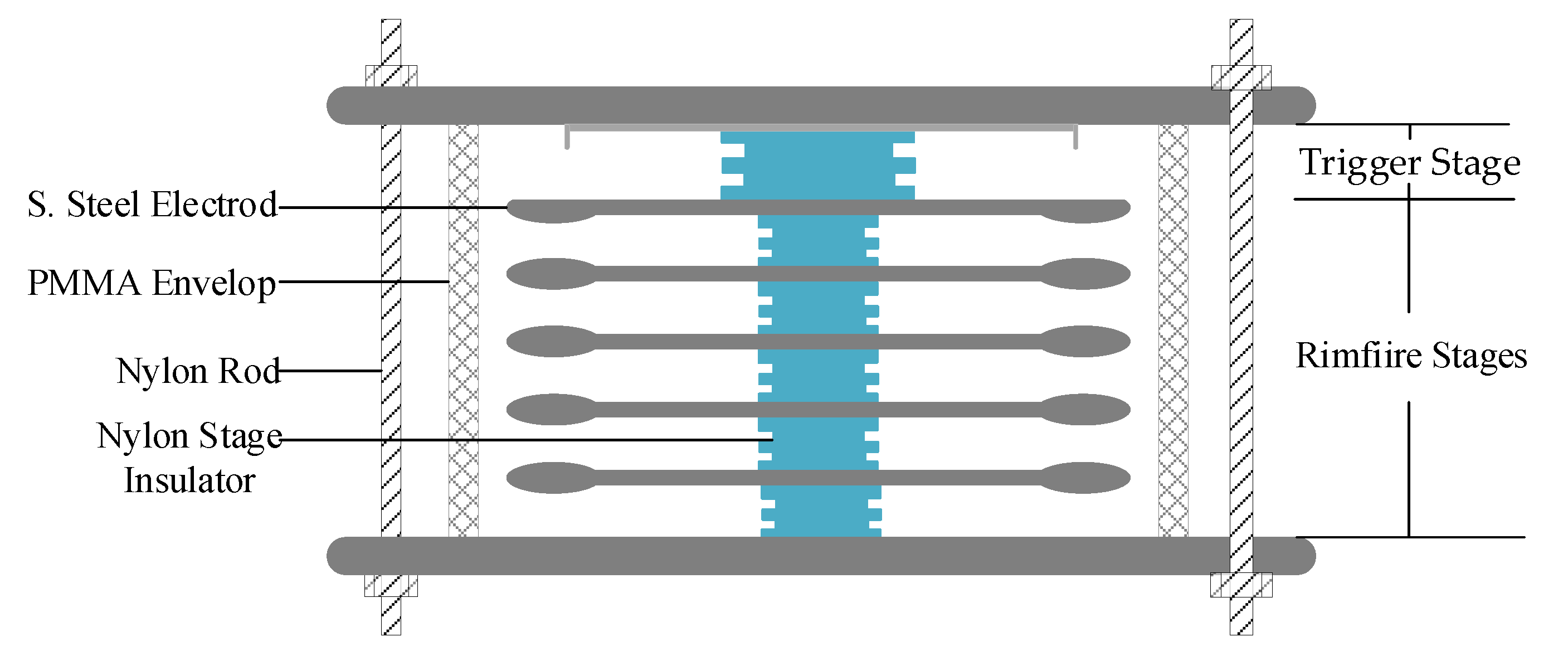
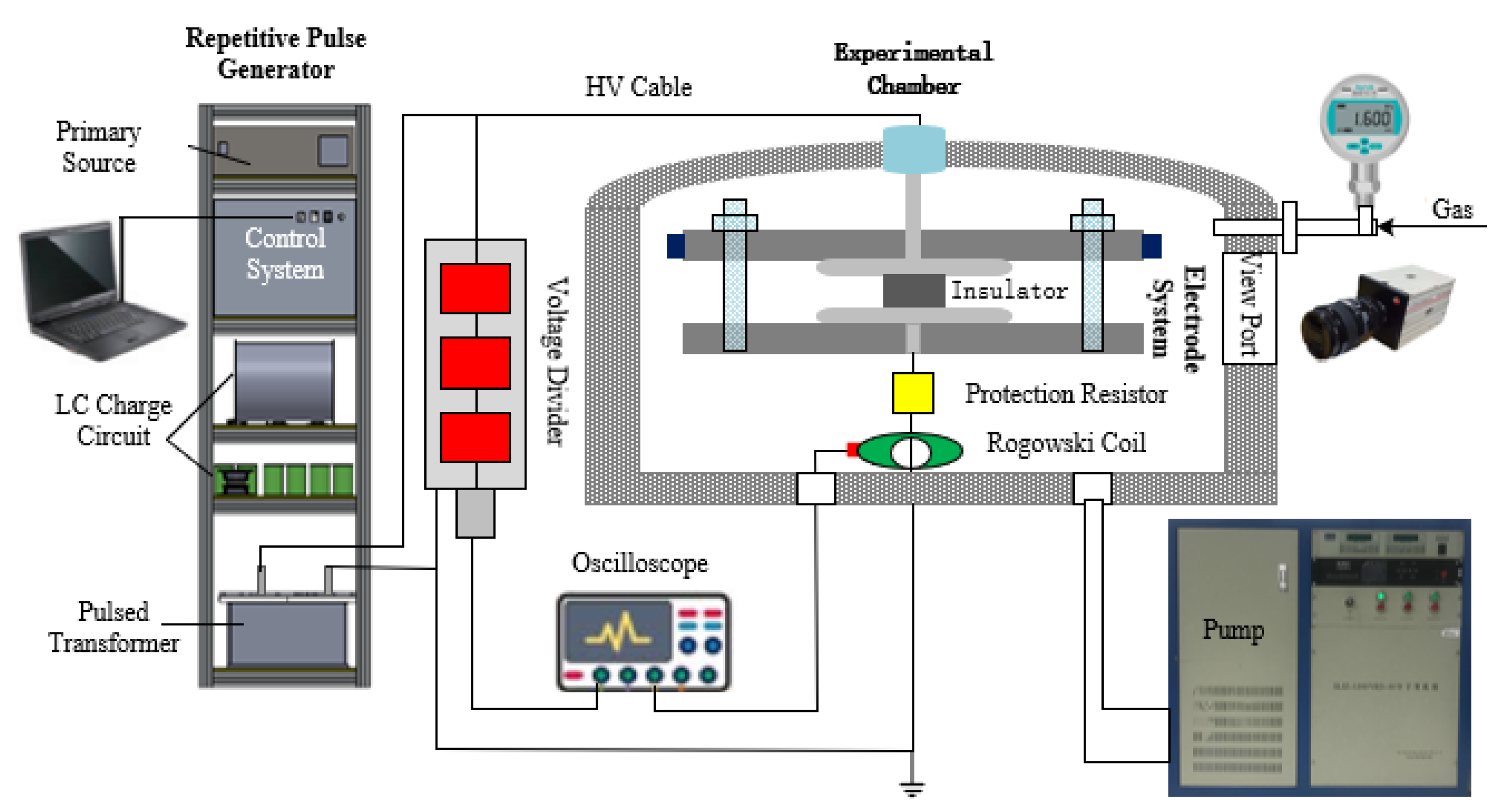


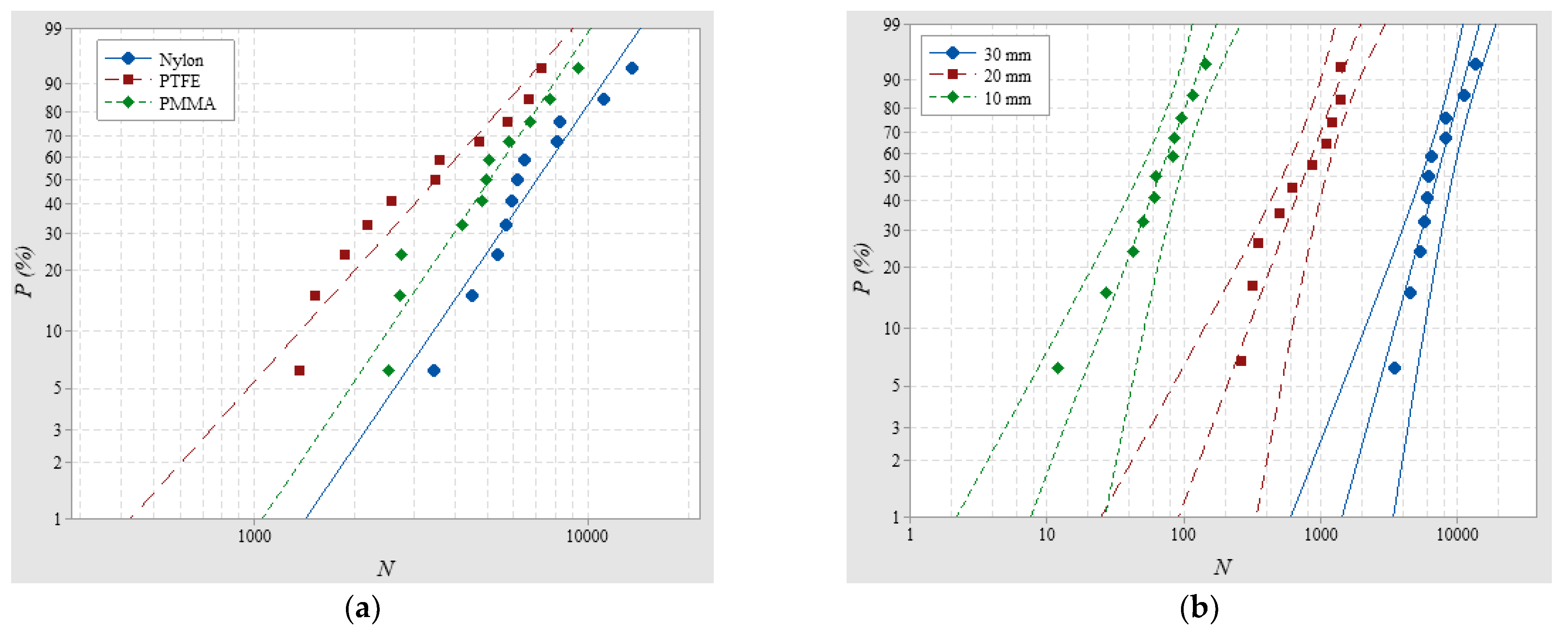

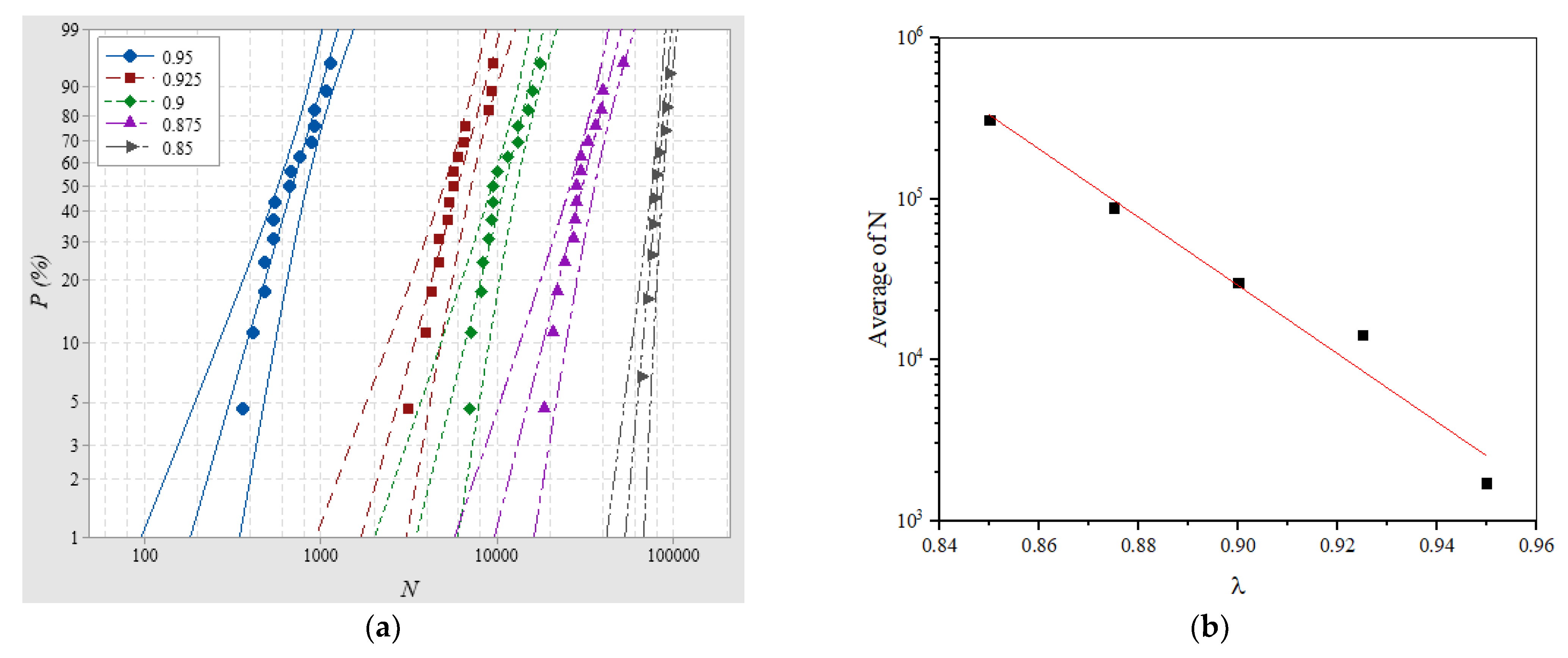
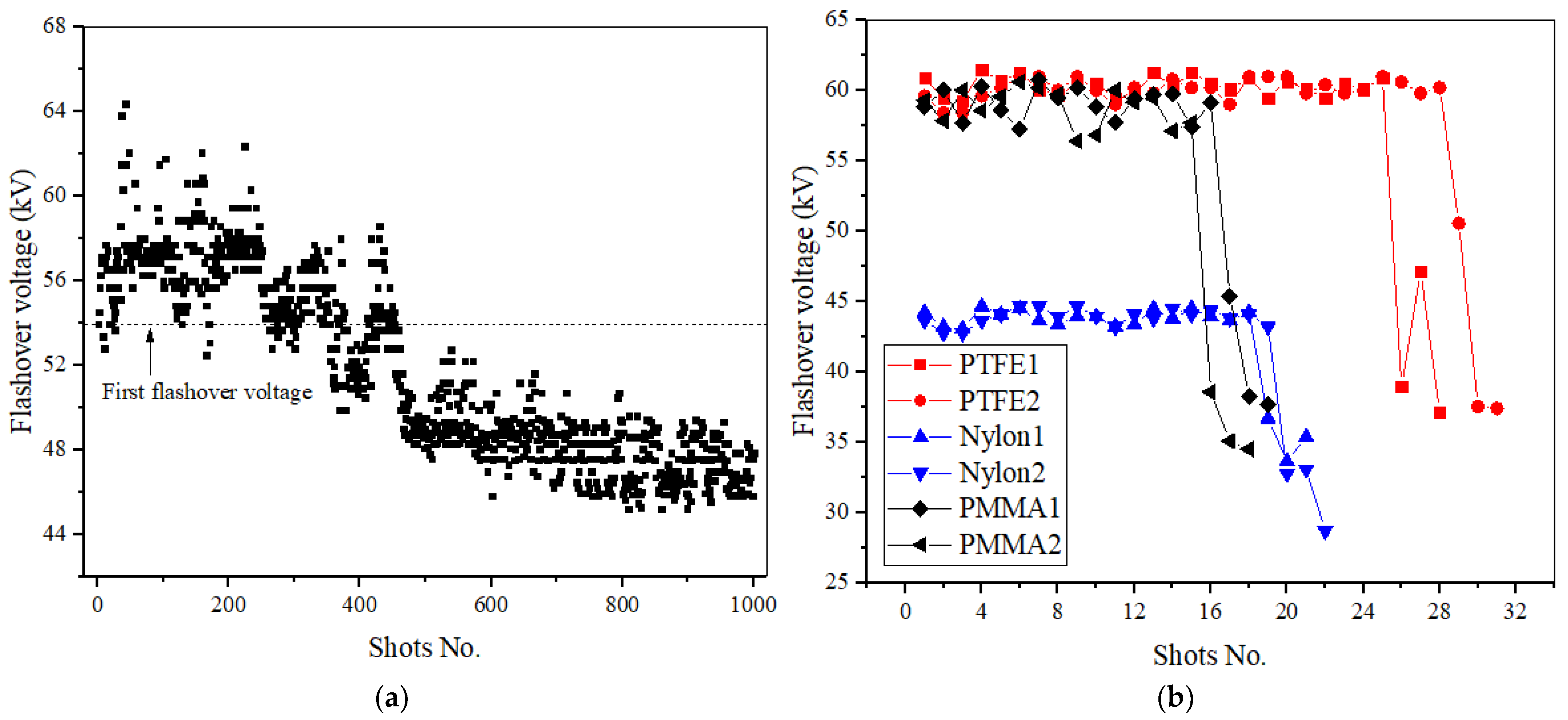
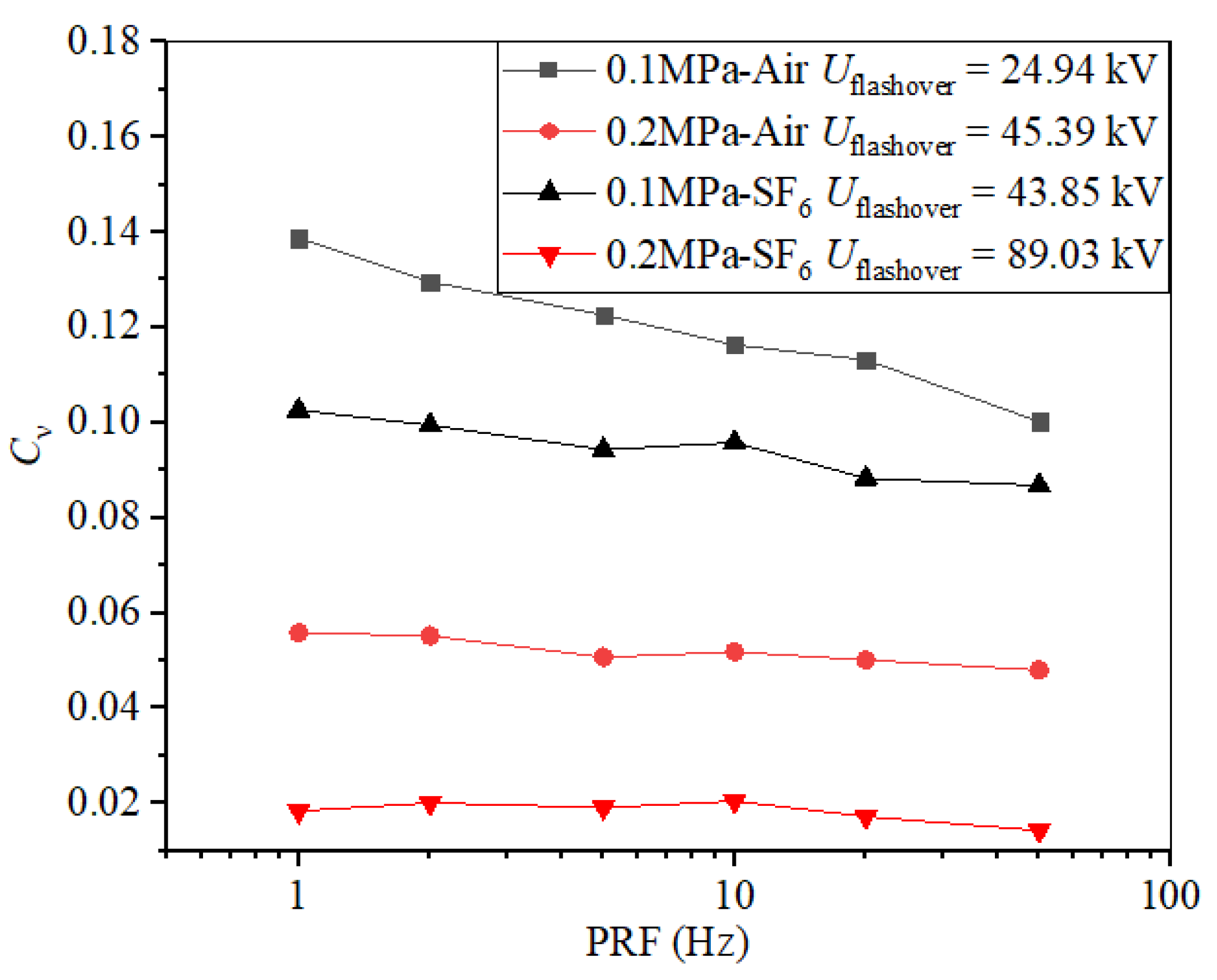

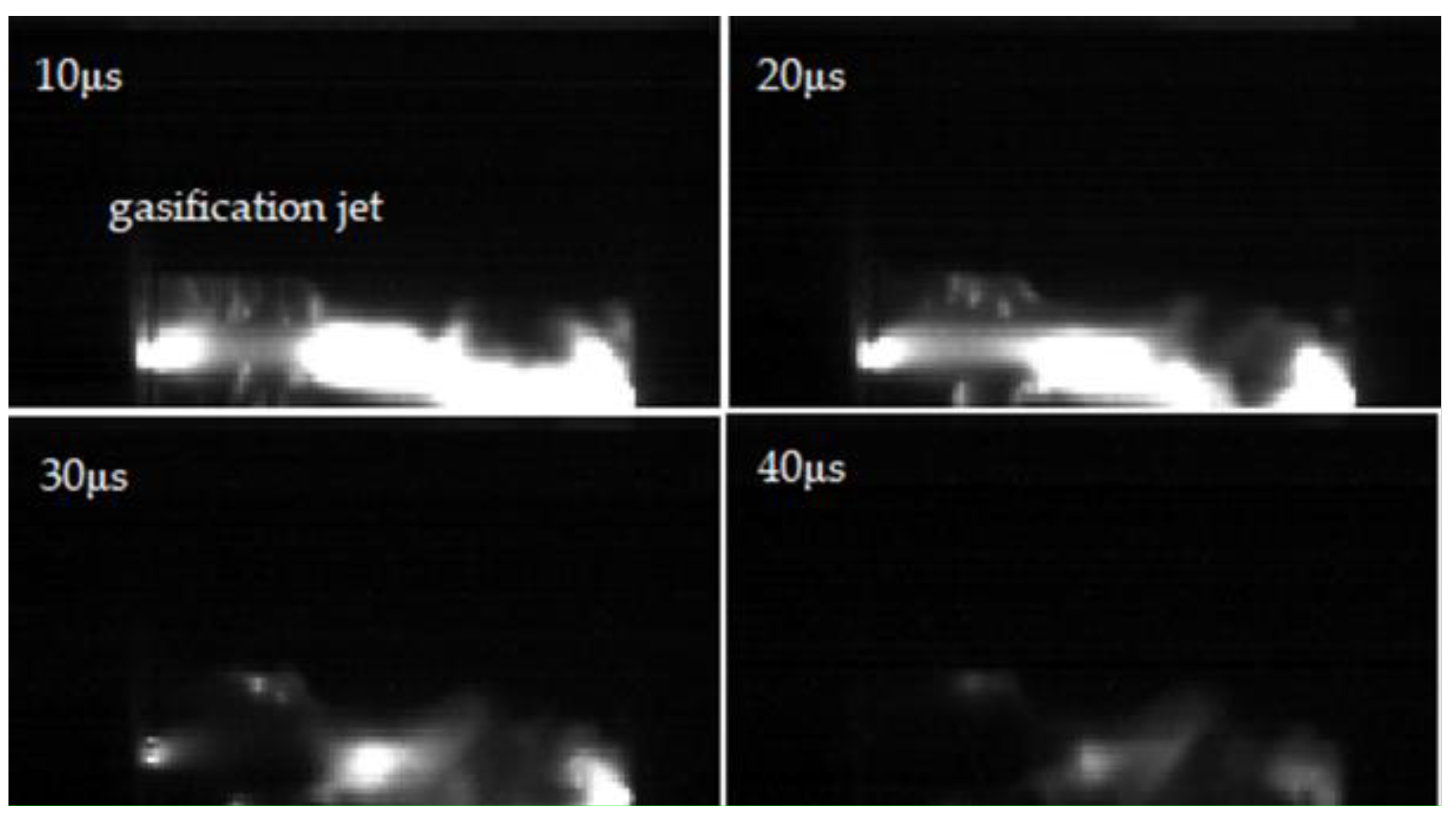


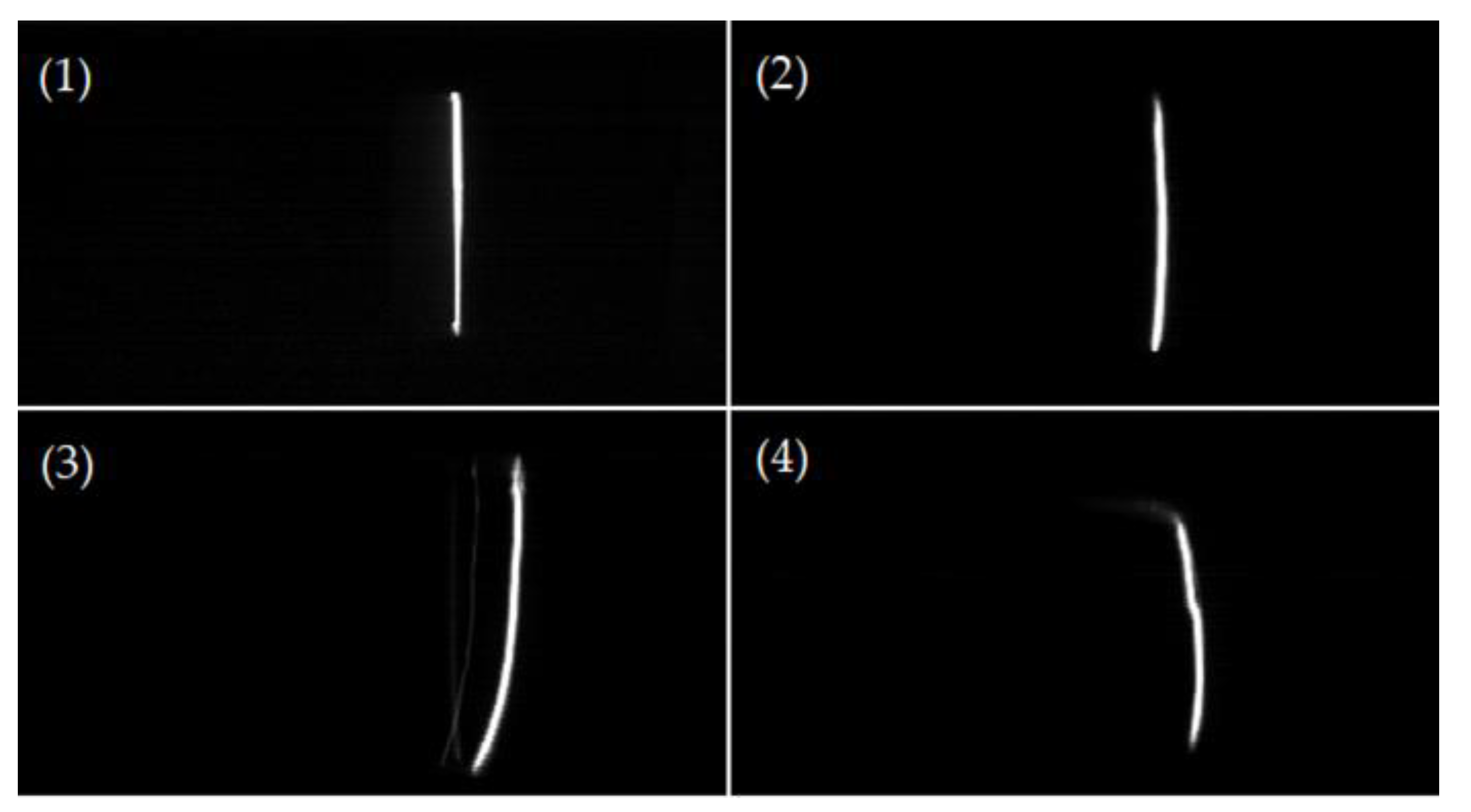




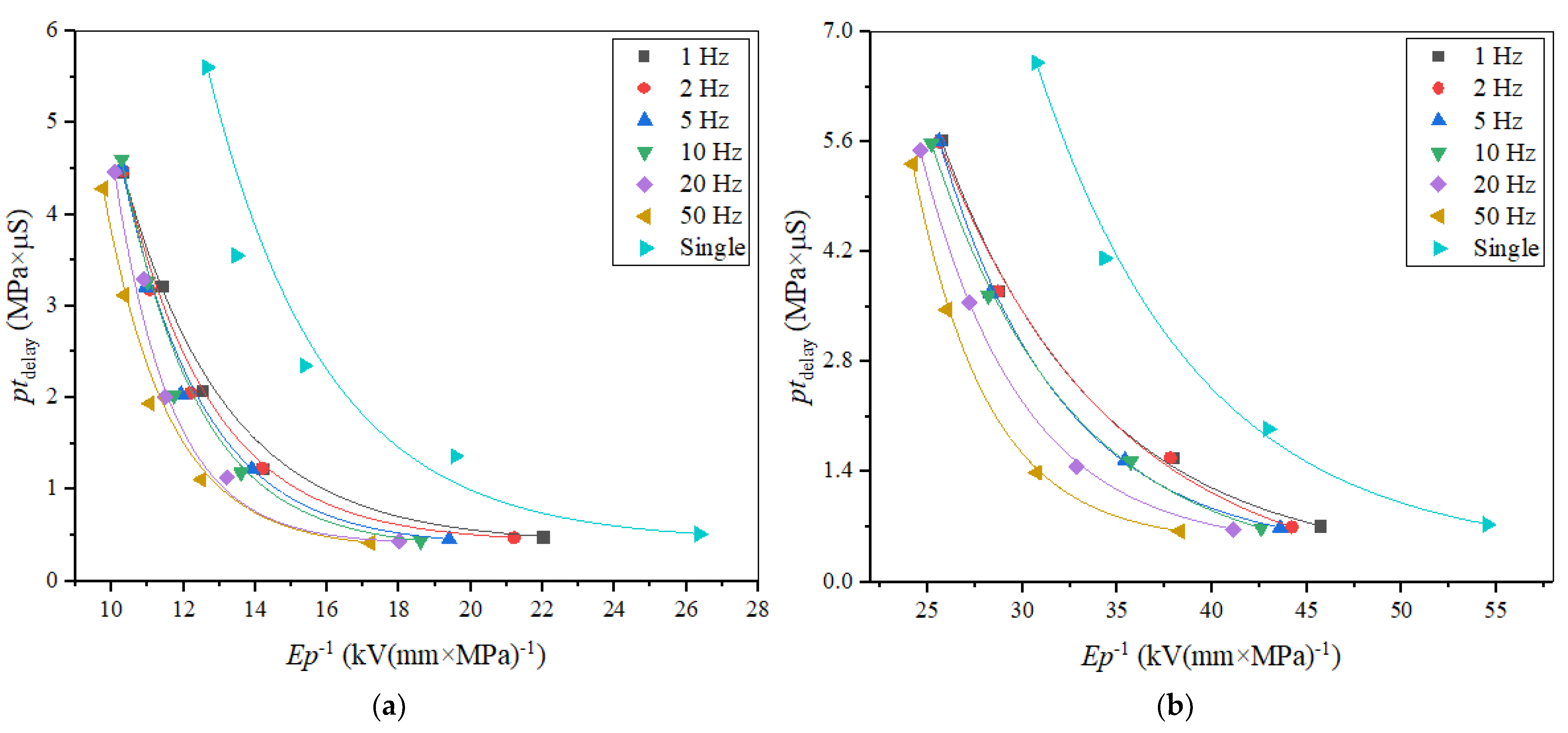


| Materials | Nylon | PMMA | PTFE |
|---|---|---|---|
| Dielectric constant | 5.0 | 2.6 | 2.1 |
| Surface resistivity (Ω/m2) | 5 × 1010 | 1014 | 1015 |
| SEE coefficient | 2.42 | 2.71 | 2.12 |
| Melting point (°C) | 220 | 150 | 327 |
| Boiling point (°C) | 452 | - | 400 |
| Shots | 500 | 1000 | 2000 | 5000 |
| Reduction | 12.04% | 14.91% | 16.24% | 18.67% |
| Gas | Nylon | PMMA | PTFE |
|---|---|---|---|
| Air | 23 | 20 | 0 |
| SF6 | 52 | 63 | 28 |
Publisher’s Note: MDPI stays neutral with regard to jurisdictional claims in published maps and institutional affiliations. |
© 2021 by the authors. Licensee MDPI, Basel, Switzerland. This article is an open access article distributed under the terms and conditions of the Creative Commons Attribution (CC BY) license (https://creativecommons.org/licenses/by/4.0/).
Share and Cite
Lin, T.; Zhang, Y.; Lu, Z.; Wang, Z.; Wei, P.; Liu, C.; Yang, L. Dielectric Surface Flashover under Long-Term Repetitive Microsecond Pulses in Compressed Gas Environment. Materials 2021, 14, 3343. https://doi.org/10.3390/ma14123343
Lin T, Zhang Y, Lu Z, Wang Z, Wei P, Liu C, Yang L. Dielectric Surface Flashover under Long-Term Repetitive Microsecond Pulses in Compressed Gas Environment. Materials. 2021; 14(12):3343. https://doi.org/10.3390/ma14123343
Chicago/Turabian StyleLin, Tianyu, Yongpeng Zhang, Zhijian Lu, Zhengwen Wang, Peng Wei, Chengying Liu, and Lanjun Yang. 2021. "Dielectric Surface Flashover under Long-Term Repetitive Microsecond Pulses in Compressed Gas Environment" Materials 14, no. 12: 3343. https://doi.org/10.3390/ma14123343






